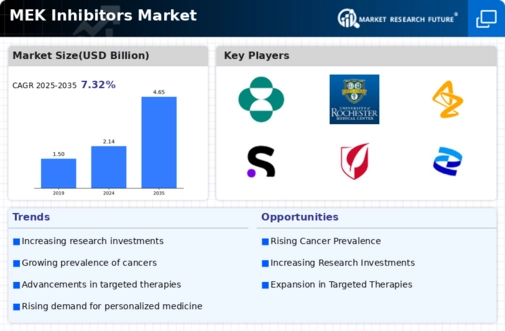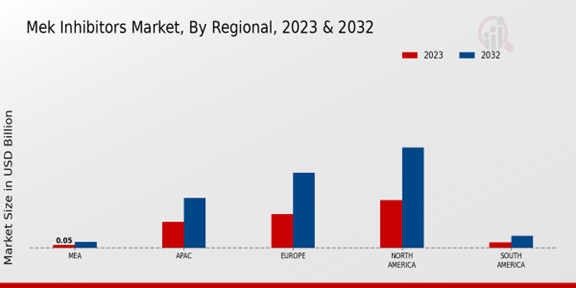Market Growth Projections
The Global MEK Inhibitors Market Industry is projected to experience substantial growth over the next decade. By 2024, the market is estimated to reach 2.14 USD Billion, with expectations to expand to 4.65 USD Billion by 2035. This growth trajectory indicates a compound annual growth rate of 7.3% from 2025 to 2035. The increasing incidence of cancer, advancements in targeted therapies, and growing investment in cancer research are key factors contributing to this upward trend. As the market evolves, it is likely to attract further investments and innovations, positioning MEK inhibitors as a critical component of modern cancer treatment strategies.
Rising Incidence of Cancer
The increasing prevalence of various cancer types globally is a primary driver for the Global MEK Inhibitors Market Industry. As cancer cases rise, the demand for effective treatment options intensifies. For instance, the World Health Organization reported that cancer cases are expected to reach 29.5 million by 2040. This surge necessitates innovative therapies, including MEK inhibitors, which target specific pathways in cancer cells. The market is projected to reach 2.14 USD Billion in 2024, reflecting the urgent need for advanced treatment modalities in oncology. Consequently, the Global MEK Inhibitors Market Industry is poised for substantial growth as healthcare systems adapt to these rising challenges.
Regulatory Approvals and Support
Regulatory approvals play a pivotal role in shaping the Global MEK Inhibitors Market Industry. The expedited review processes implemented by regulatory agencies, such as the FDA, facilitate the timely introduction of new MEK inhibitors into the market. These approvals are often based on promising clinical trial results, which highlight the efficacy and safety of these drugs. For instance, several MEK inhibitors have received breakthrough therapy designations, expediting their path to market. This supportive regulatory environment encourages pharmaceutical companies to invest in the development of MEK inhibitors, thereby enhancing market growth. The ongoing collaboration between regulatory bodies and industry stakeholders is likely to further stimulate advancements in this sector.
Advancements in Targeted Therapies
The evolution of targeted therapies significantly influences the Global MEK Inhibitors Market Industry. These therapies focus on specific molecular targets associated with cancer, enhancing treatment efficacy while minimizing side effects. MEK inhibitors, as part of this paradigm shift, are gaining traction due to their ability to disrupt the MAPK signaling pathway, which is often aberrant in tumors. The market's growth trajectory is supported by ongoing clinical trials and research, indicating a robust pipeline of MEK inhibitors. By 2035, the market is anticipated to expand to 4.65 USD Billion, driven by the increasing adoption of personalized medicine and the need for tailored cancer treatments.
Increasing Awareness and Education
Raising awareness about cancer treatment options, including MEK inhibitors, is essential for the growth of the Global MEK Inhibitors Market Industry. Educational initiatives aimed at healthcare professionals and patients are crucial for disseminating information about the benefits and availability of these targeted therapies. As awareness increases, more patients are likely to seek MEK inhibitors as part of their treatment regimen. This trend is supported by various health organizations that promote understanding of cancer therapies. Consequently, the market is expected to expand as more individuals become informed about their treatment options, leading to increased demand for MEK inhibitors in clinical practice.
Growing Investment in Cancer Research
Investment in cancer research is a crucial factor propelling the Global MEK Inhibitors Market Industry. Governments and private entities are allocating substantial resources to develop novel cancer therapies, including MEK inhibitors. For example, the National Cancer Institute has significantly increased funding for research initiatives aimed at understanding cancer biology and developing targeted treatments. This financial commitment fosters innovation and accelerates the development of MEK inhibitors, which are essential for addressing unmet medical needs in oncology. As a result, the market is expected to witness a compound annual growth rate of 7.3% from 2025 to 2035, reflecting the increasing prioritization of cancer research and drug development.






















Leave a Comment